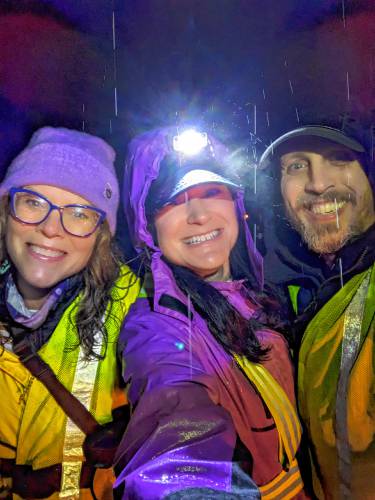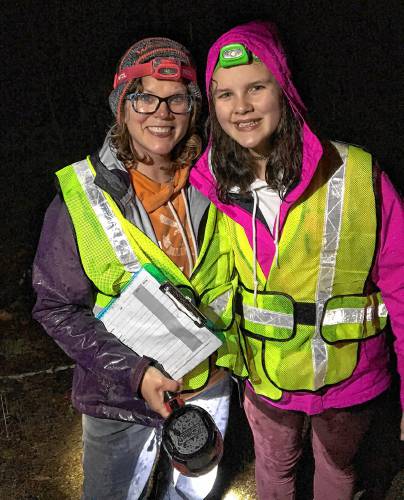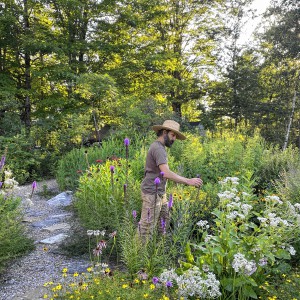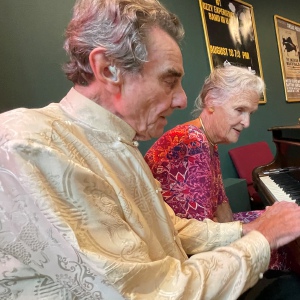Green Living: Early start to amphibian-crossing season
| Published: 03-25-2024 8:01 AM |
As the weather warms, teams of citizen volunteers have been donning rain jackets and reflective vests, heading out on the rainy nights to escort amphibians from the woodlands where they spend most of the year, crossing roadways to wetlands and vernal pools to ensure a successful breeding season.
The Harris Center for Conservation in Hancock has been organizing and training people to participate in Salamander Brigades since the early 2000s. Despite its name, the brigades help a number of species across the road to their breeding wetlands, including salamanders and various species of frogs and toads.
Brett Amy Thelen, director of community science programming at the Harris Center, said over the years, volunteers have helped tens of thousands of animals cross the road.
“Since I started at the Harris Center in 2007, there have been over 75,000,” Thelen said. “And that’s 75,000 more chances for these animals to breed – 75,000 more chances to lay eggs.”
That’s a big deal, Thelen said, because a huge amount of small amphibians are lost trying to make that journey – with Thelen saying studies have shown that 95% of vertebrate roadkill recorded are some kind of small amphibian.
“It doesn’t take a lot of cars to do a lot of damage when there are hundreds of animals about – sometimes thousands – within a single night,” Thelen said. “It’s an invisible problem, because these animals are small and hard to see, but it’s for sure an area of conservation concern.”
Spring amphibian migration is entirely dependent upon the weather, and thus doesn’t have a set time. While the height of the season is generally to be considered to be April, migration can happen any time between early March and mid-May, as long as the temperatures are above 40 degrees and the weather is rainy, after the snowpack has melted.
During wet nights, amphibians will start to migrate shortly after sunset, and continue throughout the night. And during that migration, many of them will have to cross roadways to get to vernal pools to lay eggs. During that time, they are vulnerable to being hit by passing cars. That’s where the Harris Center’s Salamander Brigade comes in.
Article continues after...
Yesterday's Most Read Articles
So far this year, Harris Center citizen volunteers have helped amphibians across the road to their breeding wetlands on two nights – including one on Feb. 28, which was the second-earliest migration that the Harris Center has recorded in its 18 years of tracking the data. The earliest record the Harris Center has of a crossing was Feb. 25, 2017.
That first crossing night, a total of 33 volunteers helped to move a total of 142 individual amphibians, consisting of seven different species, across the road at nine crossing sites across the Monadnock region. A further two sites were monitored but didn’t have any activity.
In 2017, following the early start to the crossing season, there were further snowfalls and cold temperatures in March, and the next migration didn’t happen until April 6. This year, however, warm weather continued into March, and there was another night where conditions were right for crossing on March 6, and it was a much busier night. While not a record, it was still very early in the season to see crossing activity.
A total of 100 volunteers helped 760 individual amphibians across 17 crossing sites across the road. They also recorded 192 amphibians who had been killed by cars – highlighting the need for these helpers in the first place.
The data collected by the citizen brigades may help identify particularly active crossings. Thelen said the Harris Center has worked with town’s like Keene to set up detours around active crossings on wet nights in the spring, or find other crossing solutions for the future, such as migration paths under roads.
While small, these amphibians are numerous, and make up a large part of the forest ecology, Thelen said, serving as a food source for most vertebrate birds and small and medium-size mammals that share their habitat, and acting as a predator for insect species.
“They’re a huge part of forest ecosystems,” Thelen said. “Lots of systems and networks in our woods would fall apart without the presence of amphibians.”
Thelen said the Harris Center has already conducted its in-person training for the brigades for this year, but for those that want to get involved, the Harris Center hosts links to training videos and materials on its website. Thelen strongly encouraged those who are interested in joining an existing brigade, or starting their own if they know of a potential crossing area in their neighborhood, to engage with the training materials and to take suitable precautions for being on the road at night during low-visibiity weather, including wearing reflective clothing and carrying a bright light.
For information about the brigades, visit harriscenter.org/programs-and-education/citizen-science/salamander-crossing-brigades.
Ashley Saari can be reached at 603-924-7172, Ext. 244, or asaari@ledgertranscript.com. She’s on X @AshleySaariMLT.




 Fassett Farm Nursery in Jaffrey focuses on native plants
Fassett Farm Nursery in Jaffrey focuses on native plants Bernie Watson of Bernie & Louise dies at 80
Bernie Watson of Bernie & Louise dies at 80
